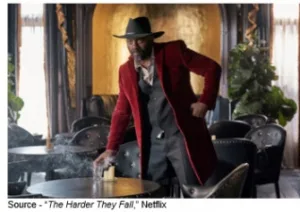We really like movies. In fact, we watched two pretty decent movies last weekend. Clicked through our streaming services, found a couple on our “gotta catch this” list and watched them. It’s been that way for several years … even before the pandemic.

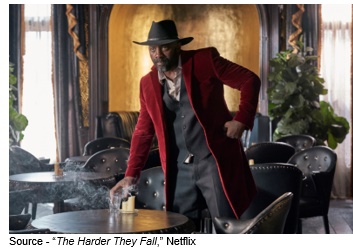 “I hear patience is a virtue. But I ain’t never been able to wait to see if that’s true.” – Jim Beckworth, “The Harder They Fall,” Netflix, 2021
“I hear patience is a virtue. But I ain’t never been able to wait to see if that’s true.” – Jim Beckworth, “The Harder They Fall,” Netflix, 2021
There are films from here and abroad with good plots, good scripts, good acting, good editing/post work. The award folks have consistently looked down their noses at such projects – unless they’re getting paid to be in them – but to each their own. It takes a really great film to get us out of the house and into a theater seat.
Stuff like Top Gun: Maverick and Jurassic World: Dominion were no Casablanca; but from the outset, they were envisioned as projects that would be bigger than the big screen. From the get-go, folks squeezed everything out of everything to maximize the large screen, Dolby Atmos sound made it so it could only truly be experienced with 100 +/- perfect strangers.
We also promised no one in particular that we’d be back in our local IMax later this year to enjoy the oversalted, greasy, expensive popcorn and immerse ourselves in James Cameron’s Avatar: The Way of Water.
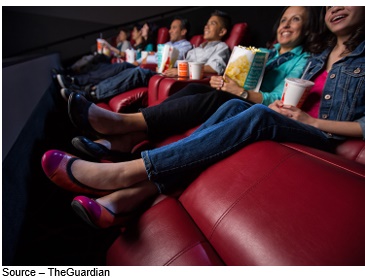 Communal Enjoyment – Catching a movie in a theater is more than just a few hours of entertainment. It’s really about being with people and sharing the highs, lows and fun of a film together.
Communal Enjoyment – Catching a movie in a theater is more than just a few hours of entertainment. It’s really about being with people and sharing the highs, lows and fun of a film together.
Every time we’ve spent time watching a film at home, we never felt much was missing. We’re not movie snobs; but for most films, good enough is good enough. Traipsing to the movie house and dropping $100 +/- on tickets, popcorn and confections to spend a few hours in their house doesn’t add much!
We never set out with the idea we had to have a home theater. Hey, a nice sized screen tucked in the corner was good enough. Like most folks, the home TV was just a way of hanging out with the family and wasting a few hours in the evening before going to bed.
 Home Stuff – Going to the movie theater is fine but there’s just something about a family sharing a movie at home, talking about it, laughing/crying with it and simply enjoying each other that is tough to replace. Image:Pexels
Home Stuff – Going to the movie theater is fine but there’s just something about a family sharing a movie at home, talking about it, laughing/crying with it and simply enjoying each other that is tough to replace. Image:Pexels
We would pop some corn and hang out together watching something on one of the 500+ channels in our cable bundle. It didn’t much matter what was on the screen. The movies were just TV shows with a longer plot and huge globs of boring ads inserted just when things were getting interesting.
It was only after signing up for our first streaming service that we realized we really could sorta enjoy Hollywood content on the home screen. Once you have a new, better form of content, you might as well improve the environment. For most households it starts simply enough … a new, larger, more impressive screen. The newer … the bigger … the more impressive.
Easy peezy; but as any true audio/video aficionado will tell you, it’s more. That’s probably why we’ve upgraded/replaced our family room TV set more than we have our smartphone. After all, the phone is connection device – good for email on-the-go, texting and the occasional call. (Well, Andy, that’s a view from our generation, but not for youngsters – ed.)
At this year’s CES, we were only mildly interested in what was new in screens because our set was reasonably new and seemed big enough. Up to a point size matters, but not as much as picture quality.
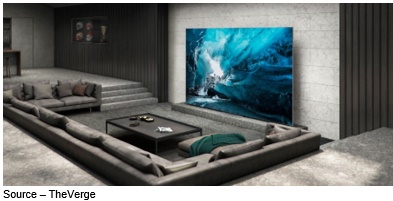 Overkill – TV makers keep making bigger and bigger screens, but should they dominate the home? Quality of presentation is a lot more than size, despite what manufacturers say.
Overkill – TV makers keep making bigger and bigger screens, but should they dominate the home? Quality of presentation is a lot more than size, despite what manufacturers say.
The set makers were hungry this year, putting their best-looking screens forward – QD-OLED, QLED, MiniLED, MicroLED, QLED, 4K, 8K – each one bigger, better, more enticing than the last. Since we had upgraded/remodeled our family room pre-pandemic, it needed a new screen. Choosing isn’t easy – OLED or QLED – because even “experts” have preferences.
OLED (Organic Light-Emitting Diode) uses an organic film with two conductors that emit light, so each pixel produces the desired brightness, image creation (great contrast). The sets are also remarkably thin and light.
The downside to OLED is that it has a tough time producing brightness as with the average backlit screen and it’s potentially subject to image retention/burn-in. (but maybe not for Samsung’s QD-OLED – ed.)
QLED – Quantum dot Light Emitting Diode – has the best features of OLED (super-deep blacks, amazing contrast, wide viewing angles) and superior brightness/color. Yeah, we went with a QLED screen. (you’re entitled to your opinion, but OLED v QLED is a bit of a religious argument! -ed)
We didn’t mount our TV high up on the wall – using a normal viewing height credenza instead – because staring up at the screen is not the way entertainment is meant to be viewed. Your TV should always be at eye level of where you’re seated.
Smart vs. Dumb?
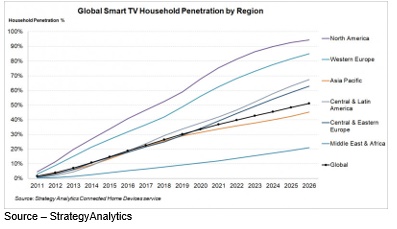 Smart Sets – Screen manufactures have worked hard to make the new smart TV sets bigger, better, brighter and easier to connect/use. It all comes at a trade-off.
Smart Sets – Screen manufactures have worked hard to make the new smart TV sets bigger, better, brighter and easier to connect/use. It all comes at a trade-off.
We sorta went along with the leading streaming screen solution – smart TV – but… Smart TVs eliminate the need for a standalone streaming device (Roku, Apple TV, Amazon Fire, Chromecast), are probably much easier to set up and come preloaded with streaming apps you may or may not want.
Our biggest “issue” with using the smarts goes back to Vizio’s initial smart TV launch. They forgot to tell Vizio screen buyers that their smart TV was designed to enable the company to harvest all of the consumers’ usage information so they could sell it to “interested parties.”
Who would have thought folks would be upset because the company scraped and pedaled personal information for a little added profit?
Now smart sets from Samsung, LG, Hisense, TLC and the rest of the screen makers do the same thing. They’re scraping so much data from us we just don’t know why they don’t give you the set and make up the difference one data point at a time.
Yes, we went along with a 60-in. smart QLED 8K but disabled the smarts, opting instead for our cable/internet service provider’s new Comcast Flex box. In addition, we use Plex (www.plex.tv) because it puts all the streaming movie, TV show, sports, music options in one convenient place…it’s so cool!
 FAST Option – To simplify the homeowners finding the show/movie they want, firms like Roku, Amazon, Apple and Google have developed add-on TV solutions. One of the newest is Coomcast’s Flex that enables you to quickly pick the show/movie you want, consolidating all of your entertainment viewing options.
FAST Option – To simplify the homeowners finding the show/movie they want, firms like Roku, Amazon, Apple and Google have developed add-on TV solutions. One of the newest is Coomcast’s Flex that enables you to quickly pick the show/movie you want, consolidating all of your entertainment viewing options.
Why?
Comcast is the largest cable/internet provider in the Americas and, with the acquisition of Europe’s Sky, has become one of the world’s largest TV/broadband service organizations since its formation in 1963.
So?
We feel they’ve had and been using our data since the old bundle days and know how valuable – and sensitive – the data is. We figured they’d be more interested in protecting our information rather than simply passing it around to the highest bidder(s). In addition, their box comes pre-loaded with all of the most-watched streaming apps and free/ad supported content from more than 200 streaming channel sources.
Okay, so it’s like the old pay TV bundle in a new skin, but it doesn’t come with the old pay TV bundle price … we can handle that!
But!
We wanted something more than just a bigger, better image. We remember when we were a guest of Dolby in 2013 at their unveiling of the then new film, Gravity, and Dolby Atmos, their revolutionary spatial audio technology for a true immersive sound experience. Sitting in the Dolby Theater down in LA was mind altering.
Before the world shut down, Woody Woodhall, head of Allied Post, reminded us of audio’s importance while he was doing the audio editing for a New Regency project.
“Really well edited and well directed sound makes you scream in a horror movie, sweat during an action film and touches all of your senses which even well edited video can’t do,” he stated.
Did you duck as the fighters flew over in Top Gun? Could you “feel” the pressure when Phoenix pulled 7+ Gs? How about when the hot breath of the T-Rex got close enough to bite you in half? Yeah, you can thank Dolby Vision/Atmos for those experiences.
Dolby Atmos was initially designed to deliver 3D immersive sound in a theater. The audio format is object-based so audio content isn’t assigned to a specific channel but attaches sound to objects on-screen. It delivers sound from every angle, putting you in the middle of the action.
That’s what we wanted in our home!
It turns out there is a bunch of ways to accomplish it from reasonably priced speakers spread around the room up to an exotic custom-built home theater.
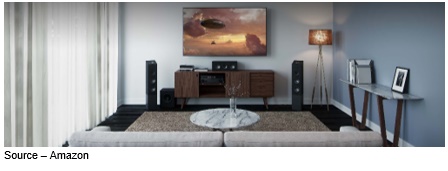 You’re There – A wide range of speaker options are available for today’s homeowner to turn their TV room into a great movie theater. A dedicated home theater may be better, but it isn’t necessary and keeps the room available for any family activity.
You’re There – A wide range of speaker options are available for today’s homeowner to turn their TV room into a great movie theater. A dedicated home theater may be better, but it isn’t necessary and keeps the room available for any family activity.
We used the inexpensive (cheap) route about a year after experiencing Gravity using some reasonably priced speakers strategically located around the room. It wasn’t elegant but the first installation was a “proof of concept” to our wife and the quality of the immersive sound more than compensated for speakers spread around the room.
We lived with that installation for 3-4 years and it was pretty good but …the more we drenched ourselves in the vibrant sound, the more improvements we wanted. When the pandemic sent everyone home, the stars seemed to be in perfect alignment. Folks quickly got tired of being “trapped” in their home and wanted to improve something, anything.
No matter where you looked, handy persons, contractors and weekend remodelers were busy sprucing up their homes. With my wife’s full agreement, we had our flat family room ceiling changed to a natural beam peaked ceiling. It not only opened up the room, it gave us a chance to run speaker and electrical wires, add ceiling light cans and mount four speakers in the ceiling.
No need to run wiring around the room just bring them down the wall behind the big screen.
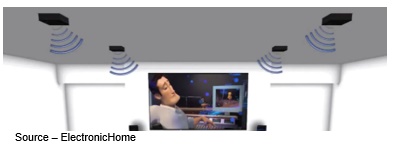 Added Immersion – While floor positioned speakers can provide an outstanding entertainment experience, there is something really special about adding ceiling-mounted speakers to drench you in content audio.
Added Immersion – While floor positioned speakers can provide an outstanding entertainment experience, there is something really special about adding ceiling-mounted speakers to drench you in content audio.
The ultrasound fills the room, and you can feel it no matter which end of the couch you’re on, just as in an AMC, IMAX, or Century theater. Woody was right about the post work on a film. The video has to be smooth, clean, crisp, well scripted and edited with the best special effects post production people can deliver. But it’s the everywhere, all-in audio that makes the film a memorable work of art.
Now that we have more subscription services (with more flexible/reasonable pricing options) there are more movie options available.
New, different, unique films from around the globe – Europe, Korea, Japan, Africa, India, everywhere – are now available on our screen, when it’s convenient for us and with living, immersive sound, just the way the producer wanted us to experience the project.
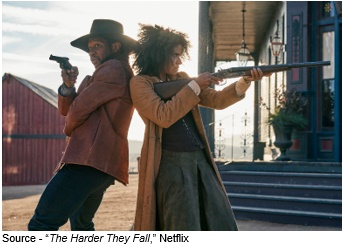 As Trudy Smith said in The Harder They Fall, “Either they can see it, or they don’t want to.”
As Trudy Smith said in The Harder They Fall, “Either they can see it, or they don’t want to.”
To which Jim Beckwourth added, “You hearsay. You don’t see-say.” Maybe Jim was wrong.
With a new large, technically advanced TV screen, you can see-say at home. And with Dolby Atmos in the room, you can hearsay … and feel it all around you.
Oh yes, to really enrich our entertainment we switched off the set’s motion smoothing. It increases the frame rate, filling in the gaps and is a total visual interruption to your viewing.
Tom Cruise and other production experts did a PSA a few years ago said it doesn’t improve anything you see on your screen and you’ll be a lot happier using “filmmaker mode”…we are!
Maximize your entertainment enjoyment and watch your movies the way they were intended to be seen…straight on in filmmaker mode and your own popcorn. (AM)
# # #
Andy Marken – [email protected] – is an author of more than 700 articles on management, marketing, communications, industry trends in media & entertainment, consumer electronics, software, and applications. An internationally recognized marketing/communications consultant with a broad range of technical and industry expertise especially in storage, storage management and film/video production fields; he has an extended range of relationships with business, industry trade press, online media, and industry analysts/consultants.

